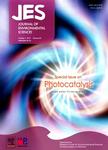Identification of key factors governing chemistry in groundwater near the water course recharged by reclaimed water at Miyun County, Northern China
Identification of key factors governing chemistry in groundwater near the water course recharged by reclaimed water at Miyun County, Northern China作者机构:Key Laboratory of Water Cycle and Related Land Surface Processes Institute of Geographic Sciences and Natural Resources Research Chinese Academy of Sciences University of Chinese Academy of Sciences Institute of Beijing Hydraulic Research
出 版 物:《Journal of Environmental Sciences》 (环境科学学报(英文版))
年 卷 期:2013年第25卷第9期
页 面:1754-1763页
核心收录:
学科分类:081803[工学-地质工程] 08[工学] 0818[工学-地质资源与地质工程]
基 金:supported by the National Basic Research Program (973) of China (No. 2010CB428805) the Beijing Important Scientific and Technological Program (No. DO7050601510703)
主 题:reclaimed water groundwater chemistry multivariate analysis Chaobai River water-rock interaction evaporation crystallization cation exchange denitrification
摘 要:Reclaimed water was successfully used to recover the dry Chaobai River in Northern China, but groundwater may be polluted. To ensure groundwater protection, it is therefore critical to identify the governing factors of groundwater chemistry. Samples of reclaimed water, river and groundwater were collected monthly at Chaobai River from January to September in 2010. Fifteen water parameters were analyzed. Two kinds of reclaimed water were different in type (Na-Ca-Mg-Cl-HCO3 or Na-Ca-Cl-HCO3 ) and concentration of nitrogen. The ionic concentration and type in river were similar to reclaimed water. Some shallow wells near the river bed had the same type (Na-Ca-Mg-Cl-HCO3 ) and high concentration as reclaimed water, but others were consistent with the deep wells (Ca-Mg-HCO3 ). Using cluster analysis, the 9 months were divided into two periods (dry and wet seasons), and all samples were grouped into several spatial clusters, indicating different controlling mechanisms. Principal component analysis and conventional ionic plots showed that calcium, magnesium and bicarbonate were controlled by water-rock interaction in all deep and some shallow wells. This included the dissolution of calcite and carbonate weathering. Sodium, potassium, chloride and sulfate in river and some shallow wells recharged by river were governed by evaporation crystallization and mixing of reclaimed water. But groundwater chemistry was not controlled by precipitation. During the infiltration of reclaimed water, cation exchange took place between (sodium, potassium) and (calcium, magnesium). Nitrification and denitrification both happened in most shallow groundwater, but only denitrification in deep groundwater.



